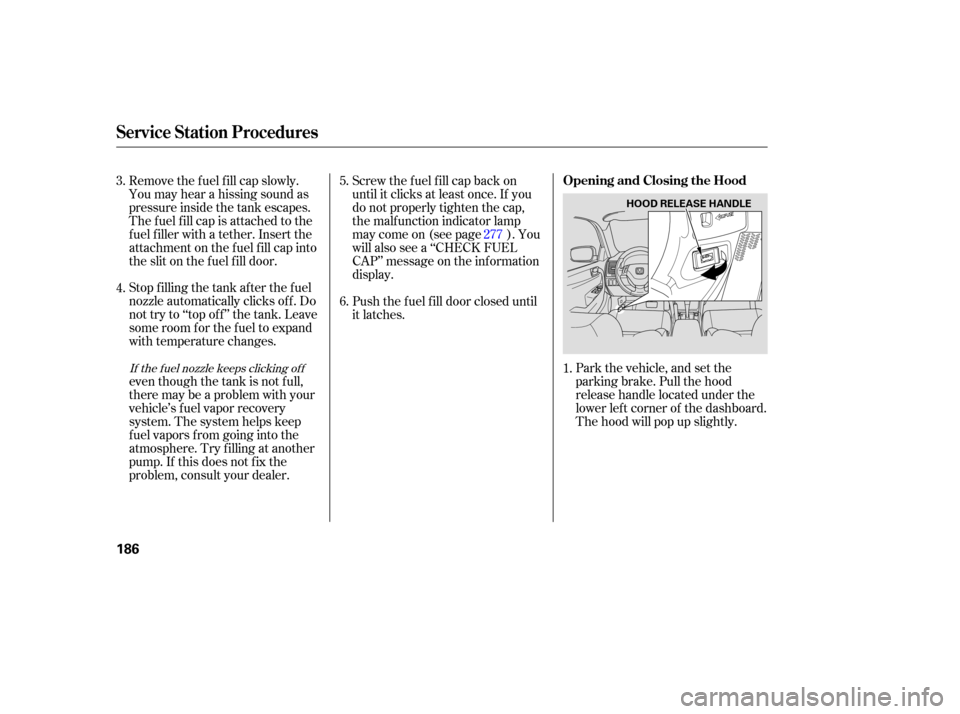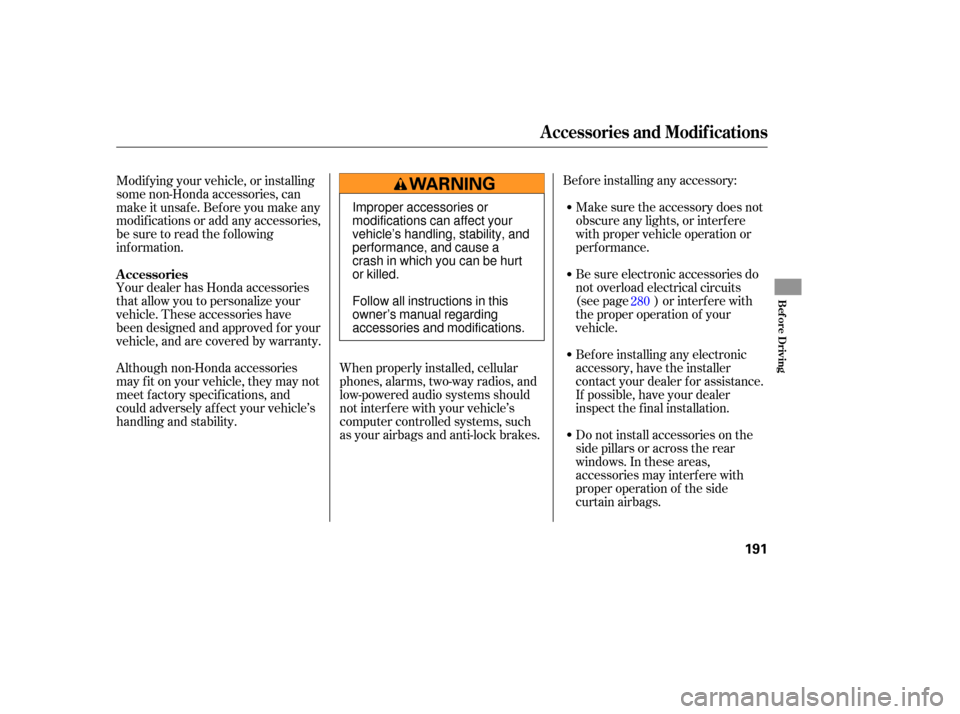Page 91 of 319

To release the seat-back from inside
the trunk, pull the release under the
trunk panel. Push the seat-back
down, then let go of the release.
To lock the seat-back upright, push it
firmly against the trunk panel. Make
sure it is latched in place by pulling
on the top of the seat. Make
sure that the folded seat-back
does not interfere with the front
passenger’s seat-back. This will
cause the front passenger’s weight
sensors to work improperly (see
page ). Also check the passenger
airb ag off indicator to assu re proper
operation of the passenger’s
advanced front airbag.
Do not put any heavy items on the
seat-back when it is folded. Make
sure all items in the trunk, or
items extending through the opening
into the back seat, are secured.
Looseitemscanflyforwardand
cause injury if you have to brake
hard. See on page
.
Never drive with the seat-back
folded down and the trunk lid open.
See on
page .
Make sure all rear shoulder belts are
positioned in f ront of the rear seat-
back, and the center shoulder belt is
re-positioned in the guide whenever
the seat-back is in its upright position.
Be sure the center shoulder belt is
not twisted. 50
25
193
Seats
Carrying Cargo
Carbon Monoxide HazardInst rument s and Cont rols
89
Pull
�����—�����—�����y�
�����������
�y���
�(���%�������y���������y
Page 98 of 319
The outside mirrors are heated to
remove fog and frost. With the
ignition switch in the ON (II)
position, turn on the heaters by
pressing the button. The indicator in
the button comes on as a reminder.
Press the button again to turn the
heaters off. To
apply the parking brake, pull the
lever up fully. To release it, pull up
slightly, push the button, and lower
the lever. The parking brake
indicator on the instrument panel
should go out when the parking
brake is f ully released (see page ).
If you drive without f ully releasing
the parking brake, the beeper
sounds continuously. 58
If equipped
Parking Brake
Mirrors, Parking Brake
96
PARKING BRAKE LEVER
HEATED MIRROR BUTTON
Driving the vehicle with the parking
brake applied can damage the rear
brakes and axle.
�����—�����—�����y�
�������������y���
�(���%�������y���������y
Page 177 of 319

Cruise control allows you to maintain
asetspeedabove25mph(40km/h)
without keeping your f oot on the
accelerator pedal. It should be used
f or cruising on straight, open
highways. It is not recommended f or
city driving, winding roads, slippery
roads, heavy rain, or bad weather.Accelerate to the desired cruising
speedabove25mph(40km/h).Press and release the DECEL/
SET button on the steering wheel.
The CRUISE CONTROL indicator
on the instrument panel comes on
to show the system is now
activated.
When climbing a steep hill, the
automatic transmission may
downshifttoholdthesetspeed.
Push in the CRUISE button on the
steering wheel. The CRUISE
MAIN indicator on the instrument
panel will come on. Cruise control may not hold the set
speed when you are going up and
down hills. If your speed increases
going down a hill, use the brakes to
slow down. This will cancel the
cruise control. To resume the set
speed, press the RES/ACCEL button.
The CRUISE CONTROL indicator
on the instrument panel will come
back on.
1.
2. 3.
Using Cruise Control
Cruise Control
Features
175
CANCEL
BUTTON RES/ACCEL
BUTTON
DECEL/SET
BUTTON
CRUISE BUTTONImproper use of the cruise
control can lead to a crash.
Use the cruise control only
when traveling on open
highways in good weather.
�����—�����—�����y�
�������������y���
�(���%�������y���
�����y
Page 178 of 319

You can increase the set cruising
speed in any of these ways:Press and hold the RES/ACCEL
button. When you reach the
desired cruising speed, release the
button.
Push on the accelerator pedal until
you reach the desired cruising
speed, then press the DECEL/
SET button. You can decrease the set cruising
speed in any of these ways:
Even with cruise control turned on,
you can still use the accelerator
pedal to speed up f or passing. Af ter
completing the pass, take your foot
of f the accelerator pedal. The vehicle
will return to the set cruising speed.
Resting your f oot on the brake or
clutch pedal cause cruise control to
cancel.
To increase your speed in very
small amounts, tap the RES/
ACCEL button. Each time you do
this, the vehicle will speed up
about 1 mph (1.6 km/h). Tap the brake or clutch pedal
lightly with your f oot. The
CRUISE CONTROL indicator on
the instrument panel will go out.
When the vehicle slows to the
desired speed, press the DECEL/
SET button. To slow down in very small
amounts, tap the DECEL/SET
button. Each time you do this,
your vehicle will slow down about
1 mph (1.6 km/h). Press and hold the DECEL/SET
button. Release the button when
you reach the desired speed.If you need to decrease your
speed quickly, apply the brakes as
you normally would.
Changing the Set Speed
Cruise Control
176
NOTE:
�����—�����—�����y�
�������������y���
�(���%�������y���
�����y
Page 179 of 319
Tap the brake or clutch pedal.
Push the CANCEL button on the
steering wheel.When you push the CANCEL button,
or tap the brake or clutch pedal, the
system will remember the
previously-set cruising speed. To
return to that speed, accelerate to
above25mph(40km/h),thenpress
and release the RES/ACCEL button.
The CRUISE CONTROL indicator
comes on, and the vehicle will
accelerate to the same cruising
speed as bef ore.
You can cancel cruise control in any
of these ways:
Push the CRUISE button on the
steering wheel. Pressing the CRUISE button turns
the system off and erases the
previous cruising speed. Resuming the Set Speed
Cancelling Cruise Control
Cruise Control
Features
177
CANCEL BUTTON
CRUISE BUTTON
�����—�����—�����y�
�������������y���
�(���%�������y���
�����y
Page 186 of 319

Help assure your vehicle’s f uture
reliability and perf ormance by paying
extra attention to how you drive
during the f irst 600 miles (1,000 km).
During this period:In addition, in order to maintain good
perf ormance, f uel economy, and
emissions control, we strongly
recommend, in areas where it is
available, the use of gasoline that
does NOT contain manganese-based
f uel additives such as MMT.
Use of gasoline with these additives
may adversely af f ect perf ormance,
and cause the malfunction indicator
lamp on your instrument panel to
come on. If this happens, contact
your authorized dealer f or service.
Avoid full-throttle starts and rapid
acceleration.
You should also f ollow these
recommendations with an
overhauled or exchanged engine, or
when the brakes are replaced. Your vehicle is designed to operate
on unleaded gasoline with a pump
octane number of 87 or higher. Use
of a lower octane gasoline can cause
a persistent, heavy metallic rapping
noise that can lead to engine damage.
Some gasoline today is blended with
oxygenates such as ethanol or
MTBE. Your vehicle is designed to
operate on oxygenated gasoline
containing up to 10 percent ethanol
by volume and up to 15 percent
MTBE by volume. Do not use
gasoline containing methanol.
We recommend using quality
gasolines containing detergent
additives that help prevent fuel
system and engine deposits. If you drive with the low engine
speed (below than about 1,000 rpm),
you may f eel the engine knocking. In
this case, you can use premium
unleaded gasoline with a pump
octane number of 91 or higher to
prevent the engine f rom knocking.
Avoidhardbrakingforthefirst
200 miles (300 km).
Do not tow a trailer. Do not change the oil until the
scheduled maintenance time.
On EX-V6 model with manual
transmission
Break-in Period Fuel Recommendation
Break-in Period, Fuel Recommendation
184
�����—�����—�����y�
���������
���y���
�(���%�������y���
�����y
Page 188 of 319

Park the vehicle, and set the
parking brake. Pull the hood
release handle located under the
lower left corner of the dashboard.
The hood will pop up slightly.
Stop
filling the tank after the fuel
nozzle automatically clicks off. Do
not try to ‘‘top off’’ the tank. Leave
some room for the fuel to expand
with temperature changes.
even though the tank is not full,
there may be a problem with your
vehicle’s fuel vapor recovery
system. The system helps keep
fu el vapors from going into the
atmosphere. Try filling at another
pump. If this does not fix the
problem, consult your dealer.
Remove
the fuel fill cap slowly.
You may hear a hissing sound as
pressure inside the tank escapes.
The fuel fill cap is attached to the
fuel filler with a tether. Insert the
attachment on the fuel fill cap into
the slit on the fuel fill door.
Push the fuel fill door closed until
it latches.
Screw the f uel f ill cap back on
until it clicks at least once. If you
do not properly tighten the cap,
the malf unction indicator lamp
maycomeon(seepage ).You
will also see a ‘‘CHECK FUEL
CAP’’ message on the inf ormation
display.
5.
6.
1.
3.
4.
277If the f uel nozzle keeps clicking of f
Service Station Procedures
Opening and Closing the Hood
186
HOOD RELEASE HANDLE
�����—�����—�����y�
�������������y���
�(���%�������y���
�����y
Page 193 of 319

When properly installed, cellular
phones, alarms, two-way radios, and
low-powered audio systems should
not interfere with your vehicle’s
computer controlled systems, such
as your airbags and anti-lock brakes. Befo
re installing any accesso ry:
Make sure the accessory does not
obscure any lights, or interfere
with proper vehicle operation or
performance.
Modifying
your vehicle, or installing
some non-Honda accessories, can
make it unsafe. Before you make any
modifications or add any accessories,
be sure to read the following
info rmation.
Your dealer has Honda accessories
that allow you to personalize your
vehicle. These accessories have
been designed and approved for your
vehicle, and are covered by warranty. Be sure electronic accessories do
not overload electrical circuits
(see page ) or interf ere with
the proper operation of your
vehicle.
Although non-Honda accessories
may f it on your vehicle, they may not
meet f actory specif ications, and
could adversely af f ect your vehicle’s
handling and stability. Bef ore installing any electronic
accessory, have the installer
contact your dealer for assistance.
If possible, have your dealer
inspect the f inal installation.
Do not install accessories on the
side pillars or across the rear
windows. In these areas,
accessories may interf ere with
proper operation of the side
curtain airbags.280
A ccessories
A ccessories and Modif ications
Bef ore Driving
191
Improper accessories or
modifications can affect your
vehicle’s handling, stability, and
performance, and cause a
crash in which you can be hurt
or killed.
Follow all instructions in this
owner’s manual regarding
accessories and modifications.
�����—�����—�����y�
�������������y���
�(���%�������y���
�����y